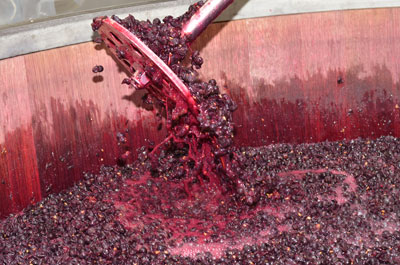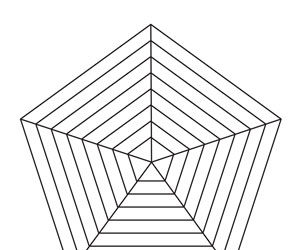
Extraction is the most important factor of red winemaking. Blanc de Noirs Champagne, for example, means white from black [grapes], and is simply a Pinot Noir (or blend) processed like a white grape — without maceration. There are a few grapes that have red pulp — Alicante Bouschet (aka Garnacha Tintorera) being the most famous — but if you want to make a red wine, extraction is of the utmost importance.
What is the best way to extract your red grapes? There is no best way, as it all depends on the style of wine you want to create, as well as considerations from the three V’s of winemaking: Vintage, vineyard, and grape variety. Some aim to extract the maximum possible, others choose a lighter extraction. Let’s take a look at what exactly gets extracted, what factors affect the extraction process, and some extraction techniques for reaching your stylistic goals.
What’s Being Extracted
After crushing your grapes, color is among the first components to extract from grapes into your fermentation. Anthocyanins — the group of phenolic compounds responsible for wine color — are present in grapes in a monomeric form. Being in this monomeric form they are smaller and more water soluble than tannins, and are easily extracted. Anthocyanin concentration reaches a maximum after about five days maceration, after which some color is reabsorbed by seeds and skins (more if stems are included). The amount of anthocyanins that extract into must reaches an equilibrium between skins and liquid must around that five-day point, and standard extraction techniques (greater agitation, temperature, time, enzymes) will not extract more.
One way of tricking your must into extracting more color is with “coextraction” techniques: Certain monomeric phenols, known as coextraction cofactors, will temporarily bind with monomeric anthocyanins, throwing off the equilibrium and allowing more monomeric color to extract into must. Two ways of increasing the amount of these cofactors in your fermentation are by cofermenting tannic white varieties with your red (only the skins are needed to increase the cofactor pool) or by using untoasted oak chips, which lead to gallic acid, and serve as a cofactor. Untoasted oak can have TCA, so be sure to source from a quality dealer. These techniques can be particularly helpful in red grapes that are high in color, low in tannin, or both.1, 2
Unlike color, most tannins are not readily extractable, and require the presence of alcohol for their liberation. Smaller, less polymerized tannins, or their monomeric building blocks, can extract early on, but most tannins have formed larger polymers and require alcohol, heat, and skin breakdown for their extraction. Different sizes of tannins, built from differing tannin building blocks, are released from the skins, stems, and seeds. Peak tannin extraction begins at around the five-day point. For the most part, skin tannins are the largest (most polymerized early on), seed tannins the smallest (least polymerized), and stem tannins cover a range of sizes and types.
Stem tannins, if you include them in your fermentation, will extract at a pace closer to skin tannins than seeds. Tannin levels and total phenolic content will be higher, but color levels, as stems adsorb anthocyanins, will be lower. Stems can give a variety of aromatics from green and “stemmy” to floral and rose-y. Stems contain water and potassium, thus will lower alcohol percentage and acidity levels, respectively. They are also known to lead to cooler fermentation temperatures.3
Unlike color, most tannins are not readily extractable, and require the
presence of alcohol for their liberation.
In addition to color and tannin, extraction introduces more of everything in a grape into a wine: Sugar, acid, aromatic precursor compounds, and so on. However, these are less difficult to extract, and discussions of extraction and extraction techniques focus on phenolics.
Factors Affecting Extraction
The main factors that affect extraction rates are temperature, agitation, and duration. The more you agitate, the longer you extract, and the higher the temperature at which you do so, will lead to higher levels of phenolics. Enzymes can also play a role, so we will briefly look at that as well.That said, regardless of your technique, at maximum, only 20–30% of a grape’s phenolic content will be extracted into your wine, and part of this depends on factors out of your control (owing to the 3 Vs mentioned earlier).
Temperature
The higher the temperature, the faster phenolics are extracted. Thermovinification and flash détente are extreme examples: These are techniques that expose red musts to temperatures of 140–185 °F (60–85 °C) for varying (relatively short) periods of time, in order to extract a maximum of grape components. In most cases, of course, red wines are fermented in the low 70s to high 80s °F (low 20s to low 30s °C). Those aiming to create a more delicate and aromatic wine, should encourage temperatures on the lower end of this range, those aiming for more complete extraction of phenolics for the higher end.
A Ribéreau-Gayon study4 from 1970 showed that at the end of 14 and 30 days of maceration, wines fermented at 86 °F (30 °C) had about 20% more total phenolic content than wines fermented at 68 °F (20 °C). Also of note, the 86 °F (30 °C) fermentation had nearly half the anthocyanin content at the end of 30 days of maceration versus the 68 °F (20 °C) fermentation.
An additional consideration with temperature is that the warmer the ferment, the more aroma will be volatilized and lost. White wines are usually fermented in the 50 to 65 °F (10 to 18 °C) range to retain aroma, and, lest we forget, red wines are essentially white wines fermented on red skins. Lower temperatures retain more aromatics, though decrease the rate of extraction — however, lower temperatures also mean slower fermentations and therefore more time on the skins extracting, so to a degree, the difference is mitigated.
Duration
There are differences in the tannins extracted in warmer, shorter fermentations versus cooler, longer fermentations. The total amount of tannins in seeds far exceeds that of the skins, but they are mostly inaccessible, so all wines contain more skin than seed tannins, but the ratio of what comes from the skins versus what comes from the seeds varies. A warmer, faster fermentation will extract a higher ratio of skin to seed tannins than longer fermentations.
Skin tannins are usually significantly more polymerized at the time of harvest (longer chains, so less bitterness, more astringency) than seed tannins. Owing to this polymerization, skin tannins are thought to lead to softer, more supple tannins earlier on, shorter ferments should lead to younger drinking, more accessible wines. For particularly drinkable, light, fruity reds, try pressing before your wine is dry, around the 5–8 day mark, before finishing fermentation.
Longer fermentations, since they will have more time extracting at higher alcohol levels, will extract more seed tannins. Smaller seed tannins will have more bitterness and less astringency than skin tannins early in a wine’s life. Extended maceration can help mature tannins.
Extended maceration is an interesting area. Many studies have shown that they lead to no increase, or a negligible one, in total phenolic content, but that they often lead to softer tannins. The exact reason for this is unknown, though some believe it comes from increased oxygen exposure during pumpovers, which encourages polymerization.3
Cold soaks are another extraction technique, and a controversial one. There is little scientific evidence that they make a difference, beyond a slight increase in total phenolics or color density at the end of fermentation, but many folks argue that it leads to increased aromatics. Cold soaking is keeping your must cold for up to a few days, precluding the initiation of fermentation. This is typically done with dry ice, cooling plates (morewinemaking.com makes a great one), or jacketed tanks. It is most common with Pinot Noir, and was a technique created to mimic the cold cellars in Burgundy, where fermentation took days to start.
Agitation
The frequency with which you punch down (or pump over) will affect the total amount of phenolics in your final wine. Less frequent punch downs will encourage lighter, more elegant wines; more frequent punch downs led to more muscular wines, perhaps with added longevity, owing to the increase in phenolics.
A consideration with agitation is that the less you do it, the higher the risk that volatile acid (VA) will develop at the top of your cap. Acetic bacteria require oxygen to function, so, if you plan to keep agitation to a minimum (one punch down per day), keep an eye out for the smell of vinegar or nail polish remover in the head space of your fermenter. It is more common at the beginning of maceration, before the yeast are producing high levels of carbon dioxide that blanket the cap, protecting it. Gassing headspace with carbon dioxide or argon prior to vigorous fermentation will help minimize risk (nitrogen, being lighter than oxygen, will be less helpful). If you do smell volatile acidity, give a good punch down, this will help submerge the bacteria, putting them into an anaerobic environment where they won’t function, and will help blow off some of the VA. Also, many producers welcome a little VA, which, though it may smell strong during moments of fermentation, may remain imperceptible in your wine, and may help to make fruit aromas “pop” and give “lift.” I’ve actually come to welcome a little VA production early in fermentation, and I am a stickler for avoiding VA in finished wines.
A consideration with agitation is that the less you do it, the higher the risk that volatile acid (VA) will develop at the top of your cap.
Another risk with less agitation is reduction, if you start to smell off odors of reduction (rotten eggs, a vague metallic scent, or general funkiness), a good punch down, getting as much air into your fermentation as possible, is usually enough to stop this problem. The more you agitate, the more oxygen you will introduce. Your yeast will thank you, as they require oxygen for optimal functioning, and your tannins will polymerize at an increased pace: Two or three punch downs per day is a reasonable amount. Any more could be a waste of time.
Enzymes
For most home (and commercial) winemakers, enzymes for extraction are likely unnecessary. During the course of a normal maceration (8–14 days) you will have extracted most of what can be extracted, which you can increase with the methods outlined above. Extraction enzymes are primarily geared at large commercial wineries who have limited tank space. When you have more fruit to process than you have tanks to ferment with, adding enzymes can give you similar extraction levels after 5 days, like you would see in twice that time without enzymes. But in the case that you are interested in reading more on using enzymes in your extraction process, see “Using Winemaking Enzymes” in the February-March 2013 issue (www.winemakermag.com/technique/using-winemaking-enzymes).
Thoughts On Post Extraction Strategies
You’ve extracted all these phenolics in your wine, now, what do you do to ensure they remain stable and give your wine a long life? We want to encourage polymerization between tannins and anthocyanins to ensure the stability of each and the longevity of your wine. Delaying polymerization will mean less complete polymerization. Although it is the subject of another article, here are three practices I have recently adopted in my reds to encourage early (and thus more complete) polymerization:
— Do not coinoculate for malolactic (ML) during alcoholic fermentation. I used to do this in my reds. Yeast consumes diacetyl, and wanting leaner wines, I wanted them to consume diacetyl as a snack. However, color and tannin bond faster at lower pH’s, so early ML completion, which raises pH, slows polymerization. To maintain a lower pH for longer and facilitate polymerization, inoculate after alcoholic fermentation, or, skip ML inoculation and allow it to occur spontaneously, which is likely your slowest option.
— Delay SO2 addition for as long as possible. SO2 consumes oxygen and creates sulfonate. Oxygen encourages polymerization, sulfonate (though it eventually dissipates) precludes certain types of polymerization. Most color will have bonded to tannins by six months, unless you have any bacterial concerns, waiting at least six months will encourage ideal polymerization.
— Rack off the lees early on but do not discard. Lees absorb oxygen as well as adsorb and enzymatically destroy color. Similar to SO2, once color is stabilized, they can safely be added back in (around six months) if properly stored. Store them in a full container and stir weekly to avoid compaction (and reduction risk). They should smell good prior to reintroducing them to your wine, not reduced (if reduced, discard them). As they absorb oxygen, they are at less risk for VA production and spoilage than wine itself.
Dialing in your extraction techniques can help you reach your style goals, as well as ensure a long and harmonious life for your wine. They can also help you to mitigate or balance out otherwise unbalanced fruit: Has a certain vineyard always had overly aggressive tannins? Try cooler temperatures, less frequent punch downs, or a shorter maceration, as an example. Different combinations of techniques, as always, will lead to different results, and fine tuning your techniques is one of the most enjoyable parts of the winemaking process.
REFERENCES:
1 Postmodern Winemaking., Smith, Clark, 2014. University of California Press, Berkeley and Los Angeles, California.
2 Roger Boulton. The Copigmentation of Anthocyanins and Its Role in the Color of Red Wine: A Critical Review. American Journal of Enology and Viticulture. Am J Enol Vitic. January 2001 52: 67-87; published ahead of print June 01, 2001
3 P. Rib´ereau-Gayon, D. Dubourdieu, B. Don`eche and A. Lonvaud, 2006 Handbook of Enology, Volume 1: The Microbiology of Wine and Vinifications 2nd Edition John Wiley & Sons, Ltd. 332 & 359. ISBN: 0-470-01034-7
4 Rib´ereau-Gayon P., Sudraud P., Milhe J.C. and Canbas, A. Recherches technologiques sur les composes phenoliques des vinsrouges. 1970 Conn. Vigne Vin, 2, 133–144.






